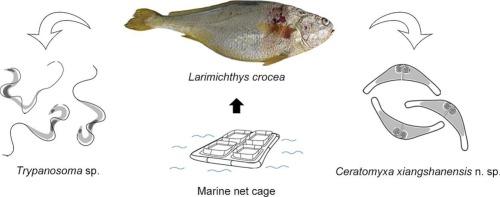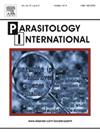Coinfection of large yellow croaker Larimichthys crocea by Trypanosoma sp. (Euglenozoa: Kinetoplastea) and Ceratomyxa xiangshanensis n. sp. (Cnidaria: Myxosporea) in offshore net cage systems in the East China Sea
IF 1.9
4区 医学
Q3 PARASITOLOGY
引用次数: 0
Abstract
The large yellow croaker, Larimichthys crocea, is an indigenous fish in the East China Sea and a highly ranked marine fish species, primarily reared in the coastal waters of the East China Sea. Recently, infections with hemoflagellates (causing trypanosomiasis) in this fish species were detected on the southeast coast of China; however, the pathogenicity has not been established. Here, an outbreak of mass mortality in L. crocea farmed in Zhejiang province is reported with coinfection of hemoflagellates and myxosporeans. For hemoflagellates, blood smears reveal elongated trypomastigotes measured 20.5 ± 3.4 μm × 1.9 ± 0.4 μm, and an anterior free flagellum is 11.9 ± 2.6 μm in length. Molecular analysis of the small subunit ribosomal sequence showed that the isolated hemoflagellate is conspecific with the Trypanosoma sp. previously reported in the Fujian province, which suggests a neglected transmission event along with transboundary fish delivery. Besides, combining morphological disparities with no more than 98.09 % molecular identity, the biliary myxosporean is regarded as a novel species, Ceratomyxa xiangshanensis n. sp. Histological examination of infected fish tissues showed trypanosome-associated pigment aggregation in melanoma-macrophage centers of the spleen and kidney. The subcutaneous tissue of the head is observed with moderate inflammatory infiltration in the dermis. We suggest that the year-round feeding operation and seasonal fish delivery may favor native circulation and transboundary transmission of these endoparasites. This work expands our knowledge of the parasite fauna harbored in reared L. crocea and frames the importance of routine surveillance for emerging parasitic diseases.

东海近海网箱系统中大黄鱼(Larimichthys crocea)被锥虫(真核纲:活动体纲)和香角虫(刺胞纲:粘孢子纲)共同感染。
大黄鱼(Larimichthys crocea)是中国东海的一种本地鱼类,也是一种高级海鱼,主要在中国东海沿岸水域养殖。最近,在中国东南沿海发现了这种鱼类的血鞭毛虫感染(引起锥虫病);然而,致病性尚未确定。在这里,报告了浙江省养殖的一场大规模死亡暴发,并伴有血鞭毛虫和粘孢子虫的共同感染。血鞭毛虫,血涂片显示细长trypomastigotes测量20.5 ±3.4 μm × 1.9±0.4 μm,和一个前免费鞭毛是11.9 ±2.6 μm的长度。小亚基核糖体序列的分子分析表明,分离的血鞭毛虫与福建省先前报道的锥虫属同源,这表明与越界鱼类传递一起被忽视的传播事件。此外,结合形态学差异和不超过98.09 %的分子同一性,胆道粘孢子虫被认为是一个新种,Ceratomyxa xiangshanensis n. sp.感染鱼组织的组织学检查显示,在脾脏和肾脏的黑色素瘤-巨噬细胞中心有锥虫相关的色素聚集。头部皮下组织可见真皮有中度炎症浸润。我们认为,全年的饲养操作和季节性的鱼类运输可能有利于这些内寄生虫的本地循环和跨界传播。这项工作扩大了我们对饲养的鳄鱼体内寄生虫动物群的认识,并阐明了对新出现的寄生虫疾病进行常规监测的重要性。
本文章由计算机程序翻译,如有差异,请以英文原文为准。
求助全文
约1分钟内获得全文
求助全文
来源期刊

Parasitology International
医学-寄生虫学
CiteScore
4.00
自引率
10.50%
发文量
140
审稿时长
61 days
期刊介绍:
Parasitology International provides a medium for rapid, carefully reviewed publications in the field of human and animal parasitology. Original papers, rapid communications, and original case reports from all geographical areas and covering all parasitological disciplines, including structure, immunology, cell biology, biochemistry, molecular biology, and systematics, may be submitted. Reviews on recent developments are invited regularly, but suggestions in this respect are welcome. Letters to the Editor commenting on any aspect of the Journal are also welcome.
 求助内容:
求助内容: 应助结果提醒方式:
应助结果提醒方式:


